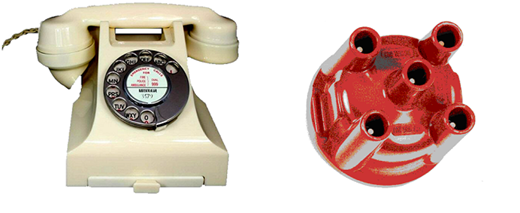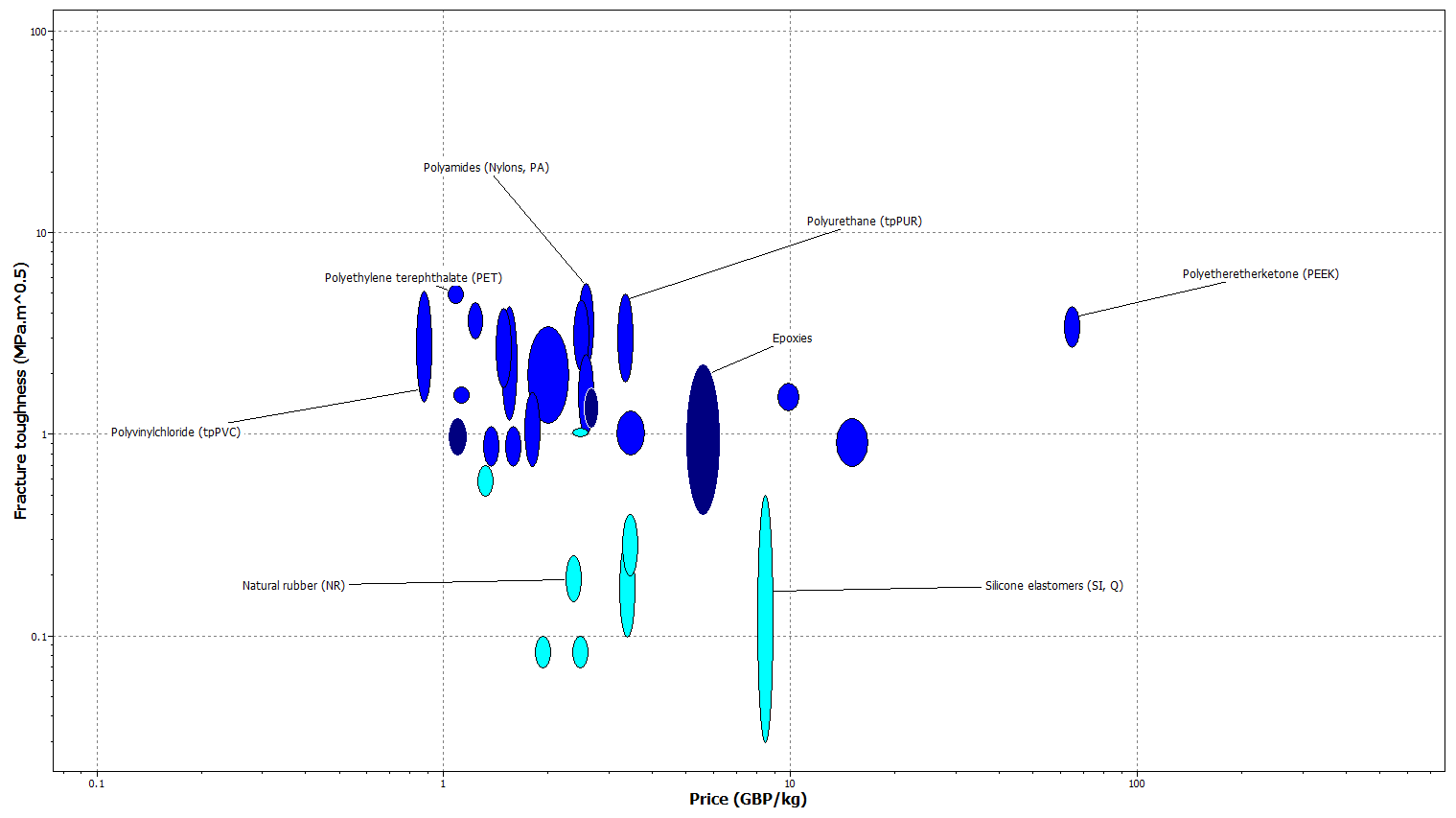Types of plastics, qualities, uses.
Types of plastics have been split into three categories, Thermoplastics(can be remolded and recycled without negatively affecting the material’s physical properties), Thermosetting plastics(irreversible curing of polymers, resulting in resistance to deformation) and Elastomers(can be either thermoplastic or thermosetting). Also see http://www.modorplastics.com/thermoset-vs-thermoplastics for Pro and Con list for Thermoplastic and Thermosetting
Thermoplastic. Plastic that becomes pliable or moldable above a specific temperature, and returns to a solid state upon cooling.
Polyoxymethylene (Acetal, POM) It is similar to nylon but is stiffer, and has better fatigue and water resistance It is rarely used without modifications: most often filled with glass fibre, flame retardant additives or blended with PTFE or PU. It has good toughness. POM is used where requirements for good moldability, fatigue resistance and stiffness justify its high price relative to mass polymers, like polyethylene, which are polymerized from cheaper raw materials using lower energy input. POM is more expensive than commodity polymers such as PE, so is limited to high performance applications in which its natural lubricity is exploited. It is found in fuel-system; seat-belt components; steering columns; window-support brackets and handles; shower heads, ballcocks, faucet cartridges, and various fittings; quality toys; garden sprayers; stereo cassette parts; butane lighter bodies and zippers.
Polypropylene (PP) Produced in very large quantities can be tailored by clever catalysis, giving precise control of impact strength, and of the properties that influence molding and drawing. In its pure form polypropylene is flammable and degrades in sunlight. Fire retardants make it slow to burn and stabilizers give it extreme stability, both to UV radiation and to fresh and salt water and most aqueous solutions.
Polypropylene is widely used in household products such as ropes, garden furniture, pipes and pipe fittings, chair shells, capacitor dielectrics, cable insulation, kitchen kettles, car bumpers, shatter proof glasses, crates, artificial turf, thermal underwear.
Polyamides (Nylons, PA) Polyamides are tough, wear well and have low coefficient of friction. Nylon (PA) can be drawn to fibers as fine as silk, and was widely used as a substitute for it. Not used as much in clothes design, but nylon-fiber ropes, and nylon as reinforcement for rubber (in car tires) and other polymers (PTFE, for roofs) remains important. It is used in product design for tough casings, frames and handles, and - reinforced with glass - as bearings gears and other load-bearing parts. There are many grades (Nylon 6, Nylon 66, Nylon 11….) each with slightly different properties.
Nylon is used for light duty gears, bearings; electrical equipment housings, tubing, bicycle wheel covers, ketchup bottles, toothbrush bristles, handles, food packaging, ropes, fishing line, carpeting, car upholstery and stockings.
Polyethylene terephthalate (PET) Often used for blow moulded bottles, audio/visual tapes, ovenproof cookware, windsurfing sails and credit cards, this material has a wide range uses. There are four grades of thermoplastic polyesters: unmodified, flame retardant, glass-fiber reinforced and mineral-filled. These all have various properties and varying strengths/weaknesses. But common PET is tough, strong, easy to shape, join and sterilize - allowing it to be reused. When its first life comes to an end, it can be recycled to give fibers and fleece materials for clothing and carpets.
Starch-based thermoplastics (TPS) Starch is a naturally occurring polysaccharide made up of glucose molecules, the bonds between the sugar molecule building blocks are different. Starch is therefore a polymer, but the problem with using it for making structural products is that it is softened by and dissolves in water. Mater-Bi is a family of biodegradable thermoplastics materials made from maize starch. They are water resistant. They retain their properties while in use, but when composted in an environment containing bacteria, they biodegrade to carbon dioxide, water and fibrous residue.
Injection moulded: pencil sharpeners, rulers, cartridges, plant pots and other toys for pets, plastic cutlery, hair combs.
Thermo-formed: trays for fresh food packaging, especially fruit and vegetables.
Film extrusion: shopping bags, bubble film for wrapping, plastic laminates for paper cups and plates, bags for rubbish disposal, lining for baby nappies, mulching films for horticulture, wrapping for fruit, vegetables and sanitary products.
Mater-Bi polysaccharide fruit packaging trays
Cellulose Acetate. Used mainly for photography as a film base, but also for glasses frames, tooth brushes & pen bodies due to its rigidity, toughness & resistance to chemicals. The fibre is often used in the textile industry to improve a materials lustre, particularly with satin. It is highly breathable and easily dyed.
Used for automotive instrument panels and other interior components, pipe fittings, home-security devices and housings for small appliances. ABS-PVC alloys are tougher than standard ABS and are used for the casings of power tools.
Low density polyethylene (LDPE), used for film and packaging whereas Medium (MDPE) and High (HDPE) density polyethylenes are stiffer and stronger; used for containers and pipes.
Polyetheretherketone (PEEK) PEEK has exceptionally high stiffness, strength and resistance to heat but it is 50 times more expensive than PP, and 10 to 20 times more than nylon. This limits it use to applications in which technical performance is paramount.
Thermosetting plastic. Plastic that changes irreversibly into an infusible insoluble polymer network by curing. Curing can be induced by the action of heat or suitable radiation.
Phenolics. Bakelite is stiff, fairly strong, could (to a muted degree) be coloured, and - above all - was easy to mold. Products that, earlier, were handcrafted from woods, metals or exotics such as ivory, could now be molded quickly and cheaply. At one time the production of phenolics exceeded that of PE, PS and PVC combined. Now phenolics still have a unique value. They are stiff, chemically stable, have good electrical properties, are fire-resistant and easy to mold - and they are cheap. Typical uses Electrical parts - sockets, switches, connectors, general industrial, relays, brake pistons, brake pads, microwave cookware, handles, bottles tops, coatings, adhesives, bearings, foams and sandwich structures
Polyester. (can also be thermoplastic) Cheapest resin for making glass or carbon fiber composites. Lower strength than epoxies. Can be made conductive by adding 30% carbon fiber. Good melt flow properties, low shrinkage, good resistance to oil and fuels. Modifications can improve chemical resistance, UV resistance and heat resistance without too much change in the ease of processing. Used for laminated structures, surface gel coatings, bowling balls, boats, skylights, fishing rods.
Elastomers. Polymer having elastic properties. E.g. rubber
Typical uses Brake seals, diaphragms, hoses and o-rings, tracked-vehicle pads, footwear, wetsuits.
Natural rubber (NR) Latex, the sap of the rubber tree, is cross-linked (vulcanized) by heating with sulfur; the amount of the cross-linking determines the properties. It is the most widely used of all elastomers - more than 50% of all produced. Natural rubber is used in medical equipment, fashion items, tubing and tires. Gloves, Car tires, seals, belts, anti-vibration mounts, electrical insulation, tubing, rubber lining pipes and pumps.
Polyurethane Most commonly they are elastomers but, like PVC, polyurethanes have thermoplastic, elastomeric and thermosetting grades. Polyurethane elastomers are thermosets, and thus cannot be recycled. Their disposal creates an environmental problem. They are easily foamed; around forty percent of all PU is made into foam by mixing it with a blowing agent. The foams are the strongest of elastomers.
Typical uses are shoe sole, tyres, gears and bearing and car bumpers. These have exceptional strength and are very abrasion resistant, making them perfect for outdoor use. They have useful properties from -55 C to 90 C. It is also the main component in soft stretchy fabrics like Lycra.
Styrene butadiene rubber (SBR)
Is the synthetic rubber that is most widely used and has the highest production volume. It is nearly always compounded with reinforcing fillers such as carbon black.
Strengths: When filled, its strength approaches natural rubber (NR) and polychloroprene. Similar chemical and physical properties to NR and somewhat better abrasion resistance.
Typical uses: Car and truck tires, belt, hose, footwear
Qualities of Plastics can be compared using CES, Cambridge Engineering Software available at the JWS building. The following graph plots the plastics fracture toughness against compressive strength. 

Fracture toughness against price:
Fatigue strength against price:

Love it, you guys put in so much work!
ReplyDeletekisses, Hugh
Bang tidy
ReplyDeleteCool and I have a tremendous proposal: What Home Renovation Shows Are On Netflix local remodeling companies
ReplyDelete